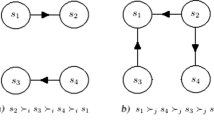Abstract
In this work, we generalize a solution concept, called symmetric sequential stability (SSEQ), in the graph model for conflict resolution (GMCR) for conflicts involving n decision makers. We present new relations of this concept with existing stability definitions in the GMCR, namely: Nash stability, general metarational stability, symmetric metarational stability, sequential stability, limited-move stability of horizon 3 and credible metarational stable states of 2 rounds. We also present the SSEQ stability definition for a coalition and its relationship with existing solution concepts in that case. Finally, SSEQ stability is extended for GMCR with uncertain, probabilistic and fuzzy preferences.








Similar content being viewed by others
References
dos Santos AM, Rêgo LC (2014) Graph model for conflict resolution with upper and lower probabilistic preferences. In: The proccedings of the 14th international conference on group decision and negotiation, vol 1, pp 208–215
Fang L, Hipel KW, Kilgour DM (1993) Interactive decision making: the graph model for conflict resolution. Wiley, New York
Fraser NM, Hipel KW (1979) Solving complex conflicts. IEEE Trans Syst Man Cybern 9(12):805–816
Hipel KW, Fraser NM (1984) Conflict analysis models and resolutions. North-Holland, North-Holland Series in System and Engineering, 377 p
Hipel KW, Fang L, Kilgour DM (1993) Game theoretic models in engineering decision making. J Infrastruct Plan Manag 470(IV–20):1–16
Hipel KW, Kilgour DM, Bashar MA (2011) Fuzzy preferences in multiple participant decision making. Sci Iranica 18(3):627–638
Howard N (1971) Paradoxes of rationality: theory of metagames and political behavior. MIT Press, Cambridge, p 247
Inohara T, Hipel KW (2008) Coalition analysis in the graph model for conflict resolution. Syst Eng 11(4):343–359
Kilgour DM (1985) Anticipation and stability in two-person noncooperative games. Dynamic models of international conflict, pp 26–51
Kilgour DM, Hipel KW, Fang L (1987) The graph model for conflicts. Automatica 23(1):41–55
Kilgour DM, Hipel KW, Fang L, Peng XJ (2001) Coalition analysis in group decision support. Group Decis Negot 10(2):159–175
Kuang H, Bashar MA, Hipel KW, Kilgour DM (2015) Grey-based preference in a graph model for conflict resolution with multiple decision makers. IEEE Trans Syst Man Cybern Syst 45(9):1254–1267
Li KW, Hipel KW, Kilgour DM, Fang L (2004) Preference uncertainty in the graph model for conflict resolution. IEEE Trans Syst Man Cybern Part A Syst Humans 34(4):507–520
Luce RD (1958) A probabilistic theory of utility. Econ J Econ Soc 26(2):193–224
Nash JF et al (1950) Equilibrium points in n-person games. Proc Nat Acad Sci 36(1):48–49
Rapoport A, Guyer M (1967) A taxonomy of \(2 \times 2\) games. Bobbs-Merrill, Indianapolis
Rêgo LC, Vieira GIA (2015) Symmetric sequential stability in the graph model for conflict resolution. In: The 15th international conference on group decision and negotiation letters, vol 1, pp 231–238
Rêgo LC, dos Santos AM (2015) Probabilistic preferences in the graph model for conflict resolution. IEEE Trans Syst Man Cybern Syst 45(4):595–608
Roberts D (1990) Rafferty-Alameda: the tangled history of 2 dams projects. The Globe and Mail, Toronto, p A4
Xu H, Hipel KW, Kilgour DM (2009) Matrix representation of solution concepts in multiple decision maker graph models. IEEE Trans Syst Man Cybern Part A Syst Humans 39:96–108
Zeng DZ, Fang L, Hipel KW, Kilgour DM (2007) Policy equilibrium and generalized metarationalities for multiple decision-maker conflicts. IEEE Trans Syst Man Cybern Part A Syst Humans 37(4):456–463
Acknowledgements
The first author would like to acknowledge the financial support of the Conselho Nacional de Desenvolvimento Científico e Tecnológico (CNPQ) and of the Fundação de Amparo à Ciência e Tecnologia do Estado de Pernambuco (FACEPE). The second author would like to acknowledge the financial support of the Coordenação de Aperfeiçoamento de Pessoal de Nível Superior (CAPES).
Author information
Authors and Affiliations
Corresponding author
Rights and permissions
About this article
Cite this article
Rêgo, L.C., Vieira, G.I.A. Symmetric Sequential Stability in the Graph Model for Conflict Resolution with Multiple Decision Makers. Group Decis Negot 26, 775–792 (2017). https://doi.org/10.1007/s10726-016-9520-8
Published:
Issue Date:
DOI: https://doi.org/10.1007/s10726-016-9520-8




